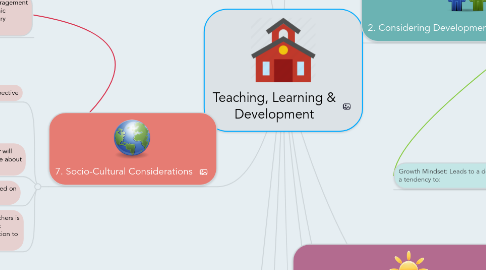
1. Diverse Learners: Purposeful encouragement of diversity and making the academic achievement of all students a primary educational goal
1.1. Strategies for Working with Diverse Learners
1.1.1. Demonstration of High Expectations
1.1.2. Implementation of Culturally Relevant Instruction
1.1.3. Establishment of Caring Relationships
1.1.4. Parent and Community Involment
2. 5. Assessing Student Progress
2.1. Purpose of Assessment: To measure and indicate student achievement
2.1.1. Diagnostic Assessment
2.1.2. Formative Assessment
2.1.3. Summative Assessment
3. Backward Design
4. Content Validity
5. Erickan's Views of Evaluative Feedback
5.1. 1. Student's Self-Esteem
5.2. 2. Student Self-Assessment
5.3. 3. Interaction in Learning Environments
5.4. 4. Teacher/Student Dialogue
6. 6. Individual Differences -Intellectual Abilities & Chalennges
6.1. Universal Design of Learning: Approach to learning, teaching, curriculum development, and assessment that uses new technologies to respond to variety of individual differences
6.1.1. 1. Representation
6.1.2. 2. Action & Expression
6.1.3. 3. Engagment
6.2. Differentiated Instruction: Variety of teaching and learning strategies that are necessary to meet the range of needs evident in any classroom.
6.2.1. 1. Content
6.2.2. 2. Process
6.2.3. 3. Products
6.2.4. 4. Learning Environment
6.3. Special Education
6.3.1. Building an Inclusive Practice for all students, including those with exceptionalities
6.3.2. Individual Education Program
7. Intelligence: "Groups of intellectual behaviours, both goal-directed and adaptive, that can have a significant impact on how and how well students learn" (193).
7.1. Fluid Intelligence
7.2. Crystallized Intelligence
7.3. Visual-Spatial Reasoning
8. Componential Sub-Theory
8.1. Analytical Abilities: In order to judge, analyze, evaluate, compare and contrast
9. Contextual Sub-Theory
9.1. Analytic Abilities: Put into practice, apply, use and impliment
10. Experiential Sub-Theory
10.1. Creative Abilities: To create, discover, invent, imagine and explore
11. 7. Socio-Cultural Considerations
11.1. Socio-Cultural Perspective
11.1.1. Positioning Cultural Identity within the Individual
11.1.2. Critical Consciousness Disposition
11.1.3. *Building a Culturally Responsive Practise: Built upon broad cultural knowledge and instructional base that grows as students, contexts and subject matter shift
11.2. Stereotype Threat: Fear that behaviour will confirm an existing negative stereotype about identity group
11.3. Socio-Economic Status: Social class based on education, occupation and income
11.4. Multicultural Education: Focus for teachers is understanding each individual student identity and how this is formed in relation to associations with various groups
11.4.1. Bank's Model
11.4.2. Aboriginal Education
12. 8. Standardized Achievement Tests
12.1. Standardized Test: Contains same questions for all test-takers and is administered and scored within a systematic and uniform manner
12.1.1. Aptitude Test: Specific ability test to assess a students' specific cognitive, social and behavioural skills
12.1.2. Achievement Test: Provides a broad overview of academic performances for large groups of students
12.1.3. How Should Better Standardized Test be Constructed?
12.1.3.1. Curriculum
12.1.3.2. Instruction
12.1.3.3. Assessment
12.1.4. In Preparing Students for Test Writing, Teachers Should Remember:
12.1.4.1. 1. A teacher's primary obligation is to teach well
12.1.4.2. 2. Educate students about test formats in order to familiarize and decrease potential stress
12.1.4.3. 3. Demonstrate positive test attitude
12.1.4.4. 4. Teach students "test wise" strategies in an attempt to reduce anxiety
12.1.5. Interpreting Test Results: In order to help teachers develop a better overall standing of their student's academic progress and highlight curricular content areas and earning processes that are well consolidated or need attention
13. "Effective student-regulated advocate strongly for teachers to provide students with, and engage students in, explicit cognitive strategies for a)making choices, b)reflecting on meaningfulness of these choices, c)seeing their choices through to completion, and d)reflecting on the outcomes of their actions" (79).
14. Dynamic Classroom Management
14.1. Motivational Underpinnings: "All behaviours are an effort to get something or an effort to avoid something, and all behaviours are maintained changed, or shaped by consequences" (76).
14.2. Positive Behaviour Support
14.3. Classroom Discourse Research
14.4. Nurturing Student Needs
15. 1. Planning for the Upcoming School Year
15.1. Reflective Practise: The importance of analyzing and reflecting upon one's teaching practice in order to become a more effective educator.
15.2. Educational Psychology
15.2.1. Schwab's Four Commonplaces: Teacher + Curriculum + Student + Classroom
15.2.2. "Psychological theories without tangible educational applications are merely exercises in academic exploration" (8).
15.3. Curriculum Design & Planning
16. Research Methods
16.1. Step 1: Observation of Phenomena
16.2. Step 2: Formation of Questions
16.3. Step 3: Application of Research Methods
16.4. Step 4: Development of Guiding Principles
16.5. Step 5: Development of Theories
17. 2. Considering Developmental Differences
17.1. Piaget's 4 stages of cognitive development
17.2. Erikson's Eight Stages of Psychosocial Development
17.3. Kohlberg's Six Stage Theory
17.4. Bronfenbrenner's Ecological Theory Featuring Five Environmental Systems
17.5. Student's Perspective: the essence of school is learning.
17.6. Teacher's Perspective: the essence of student learning is motivation.
17.7. Education Psychology Perspective: understanding motivation is key to understanding why things happen in classrooms.
18. 3. Establishing a Positive Learning Environment
19. Self-Regulated Behaviour Management
19.1. ADHD: Usually aware of their behaviours and the problems associated, but cannot control their behaviour without specific interventions
19.1.1. 'On-Task Self Monitoring Techniques
20. Growth Mindset: Leads to a desire to learn and a tendency to:
20.1. Embrace challenges
20.2. Persist in the face of setbacks
20.3. See effort as the path to mastery
20.4. Learn from criticism
20.5. Find lessons and inspiration in the success of others
20.5.1. This all results in a greater sense of free will & higher levels of achievement
21. 4. Making Instructional Decisions
21.1. Universal Instructional Design
21.2. Inquiry Based Learning
21.2.1. A Teachers Role in an Inquiry Classroom: Facilitator of Learning
